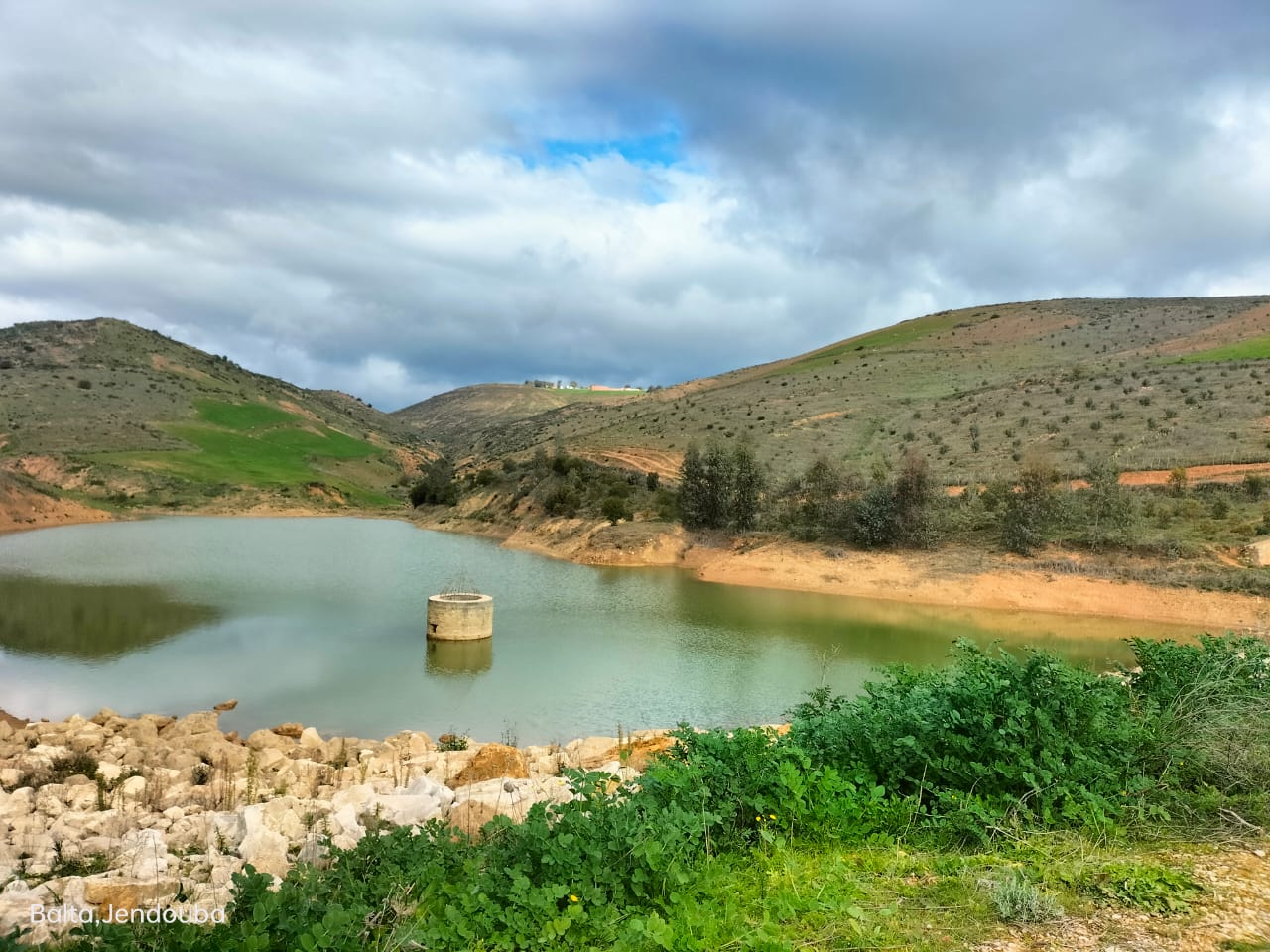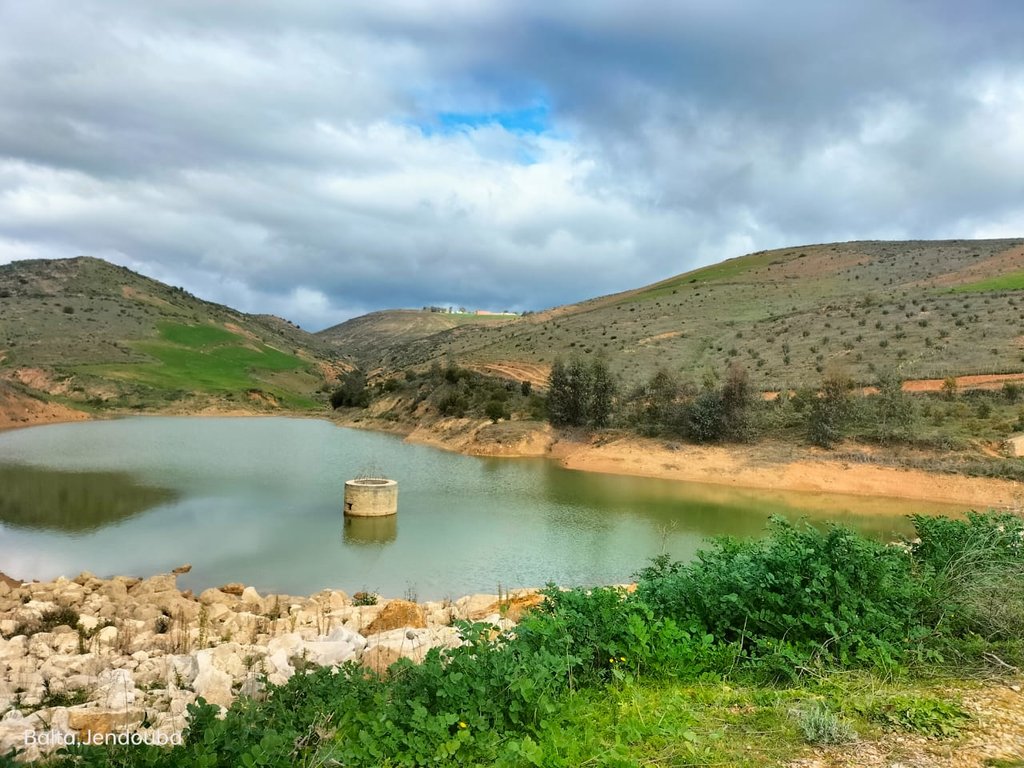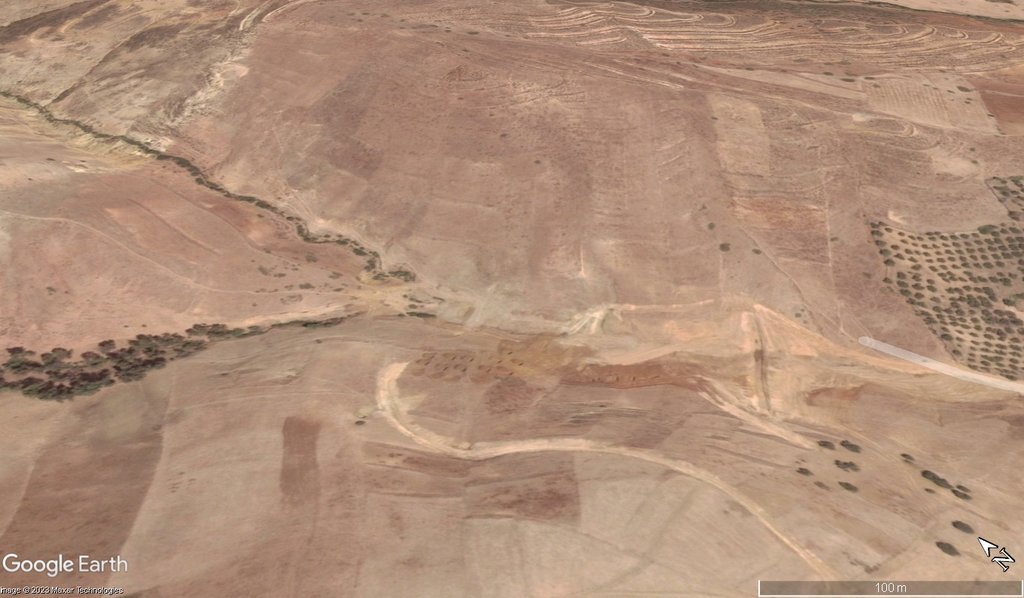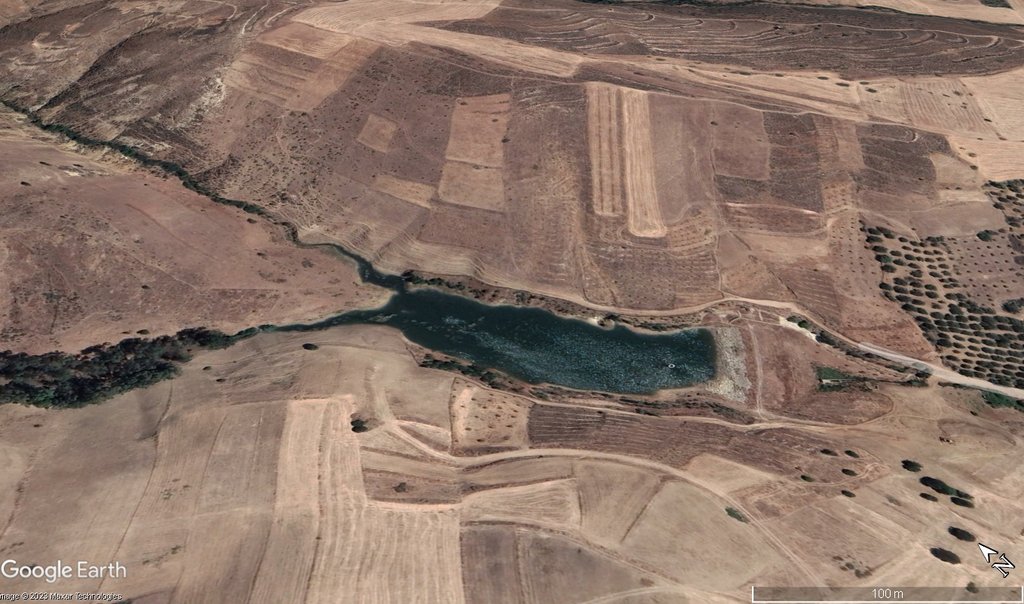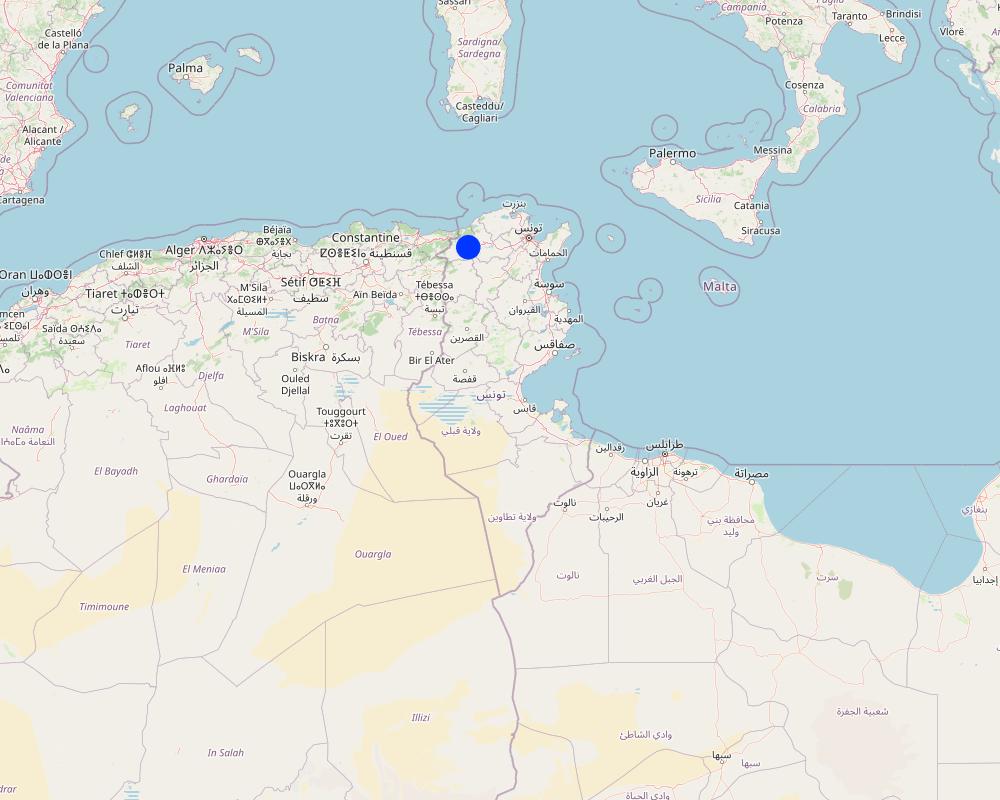Exploitation of hillside lakes [Tunisia]
- Creation:
- Update:
- Compiler: Wafa Saidi
- Editors: Siagbé Golli, Faouzi Harrouchi, faouzi BATTI, Fatma Maaloul, Tabitha Nekesa, Ahmadou Gaye
- Reviewers: William Critchley, Rima Mekdaschi Studer
approaches_6787 - Tunisia
View sections
Expand all Collapse all1. General information
1.2 Contact details of resource persons and institutions involved in the assessment and documentation of the Approach
Key resource person(s)
SLM specialist:
Bakkari Mongi
Directorate- General for Agricultural Land Management and Conservation (DGACTA)
Tunisia
SLM specialist:
Amri Héla
Directorate General for Agricultural Land Management and Conservation (DGACTA)
Tunisia
SLM specialist:
Sallemi Fadhel
Directorate General for Agricultural Land Management and Conservation (DGACTA)
Tunisia
Name of project which facilitated the documentation/ evaluation of the Approach (if relevant)
Soil protection and rehabilitation for food security (ProSo(i)l)Name of the institution(s) which facilitated the documentation/ evaluation of the Approach (if relevant)
Zuidelijke Land en Tuinbouw Organisatie (ZLTO) - NetherlandsName of the institution(s) which facilitated the documentation/ evaluation of the Approach (if relevant)
GIZ Tunisia (GIZ Tunisia) - Tunisia1.3 Conditions regarding the use of data documented through WOCAT
When were the data compiled (in the field)?
01/30/2023
The compiler and key resource person(s) accept the conditions regarding the use of data documented through WOCAT:
Yes
1.4 Reference(s) to Questionnaire(s) on SLM Technologies
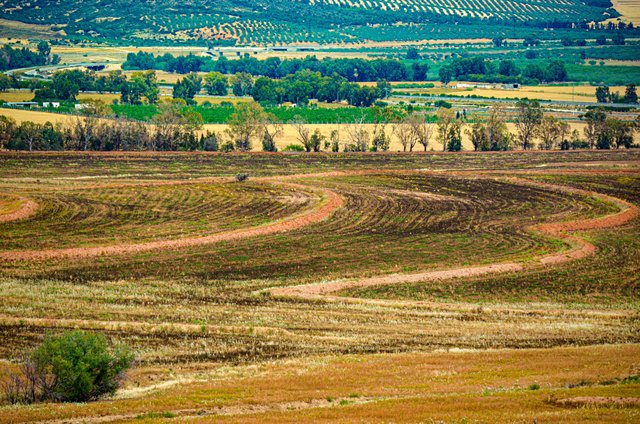
Contour tillage [Tunisia]
Contour ploughing is an agricultural technique involving the cultivation of sloping land along contour lines. This technique creates a succession of closely spaced ridges and furrows which help to retain water and soil.
- Compiler: Wafa Saidi
2. Description of the SLM Approach
2.1 Short description of the Approach
Hill lake development is an approach designed to integrate land and water management with socio-economic development.
2.2 Detailed description of the Approach
Detailed description of the Approach:
This approach is primarily aimed at harnessing natural water resources, thus contributing significantly to local development by improving living conditions, principally through fruit-growing initiatives, and thereby preventing large-scale migration from rural areas. The development of hillside lakes (or “reservoirs”) also serve as a basic source of livelihoods and well-being for local communities, for example by facilitating traditional fishing practices and providing water for livestock.
The approach contributes to bolstering local food security by providing supplies of fruit and other agricultural products. The formation of a hill lake engenders a multifaceted ecosystem, fostering wildlife habitats. Correct management can help mitigate soil erosion, safeguarding downstream infrastructure, and enhancing soil quality through nutrient cycling.
The approach has the potential to attract tourists and outdoor enthusiasts, including those interested in hiking activities.
The determination of a site for the construction of a hill lake is influenced by a request from farmers and regional and local authorities or initiated by the administration through the scouting of agricultural and human potential, with the involvement of farmers. An agro-socio-economic diagnosis and a detailed technical study (topographical, geological and hydrological) are essential steps in designing the project.
Once a lake management committee, elected by the farmers, has been set up, the administration provides irrigation equipment (a pump, irrigation pipes and cisterns).
The success of the lake’s management approach hinges on the organization of farmers around the structure, ongoing maintenance of the facility and its equipment, and the protection of its banks. In this process, the State assumes responsibility for conducting the necessary studies, overseeing construction, and providing the necessary equipment.
Land users may perceive an advantageous outcome in the form of expanded access to water for various applications, including irrigation for agriculture or livestock watering. This can lead to increased agricultural productivity, improved livelihoods and quality of life.
2.3 Photos of the Approach
2.5 Country/ region/ locations where the Approach has been applied
Country:
Tunisia
Region/ State/ Province:
Jendouba
Further specification of location:
Boulaaba, Balta Bouaouan
Map
×2.6 Dates of initiation and termination of the Approach
If precise year is not known, indicate approximate date when the Approach was initiated:
less than 10 years ago (recently)
2.7 Type of Approach
- recent local initiative/ innovative
2.8 Main aims/ objectives of the Approach
- Water and soil conservation
- Promotion of agricultural development in hilly areas
- Integrated water resource management
- Improved food security, income generation and socio-economic well-being
2.9 Conditions enabling or hindering implementation of the Technology/ Technologies applied under the Approach
social/ cultural/ religious norms and values
- enabling
The implementation of this approach is facilitated by social norms that promote community participation and collective decision-making.
availability/ access to financial resources and services
- enabling
Adequate financial resources are essential for the successful implementation of hill lake projects.
- hindering
A lack of adequate financial resources can impede the successful implementation of hill lake projects.
institutional setting
- enabling
Establishing an institutional framework, such as a management committee, is crucial to promote the implementation of the approach.
collaboration/ coordination of actors
- enabling
A convergence of interests and a shared vision for the sustainable management of water resources, soil conservation, and agricultural development enhances collaboration and fosters synergy among stakeholders.
policies
- enabling
Policies advocate for integrated watershed management, providing support for the implementation of hill lakes.
land governance (decision-making, implementation and enforcement)
- enabling
Inclusive and participatory decision-making processes that engage all relevant stakeholders, including local communities, land users, government agencies, and NGOs, foster a sense of ownership and enhance the implementation of technology.
knowledge about SLM, access to technical support
- enabling
Land users benefit from the guidance and assistance provided by technical experts, extension agents, research institutes and NGOs.
3. Participation and roles of stakeholders involved
3.1 Stakeholders involved in the Approach and their roles
- local land users/ local communities
Farmers
- Selection of a lake construction site
- Exploitation of the lake
- community-based organizations
Management committee
-Management of the use of water resources
- SLM specialists/ agricultural advisers
CRDA, CTV
-Technical assistance
- researchers
Research institutions
-Research institutions are constantly engaged in investigating hill lakes, evaluating their effects on the nearby environment and rural communities, and exploring strategies for utilizing them to promote sustainable resource management.
- private sector
Entrepreneurs
-Implementation
- national government (planners, decision-makers)
DGACTA
-Funding
3.2 Involvement of local land users/ local communities in the different phases of the Approach
| Involvement of local land users/ local communities | Specify who was involved and describe activities | |
|---|---|---|
| initiation/ motivation | self-mobilization | Incentivizing farmers to increase the impact of hill lakes |
| planning | interactive | Local farmers are involved in the planning process for the implementation of a hill lake in the region. |
| implementation | external support | Workers may include local land users. |
| monitoring/ evaluation | interactive | Involving the local population in monitoring and evaluating the hill lake |
3.4 Decision-making on the selection of SLM Technology/ Technologies
Specify who decided on the selection of the Technology/ Technologies to be implemented:
- mainly land users, supported by SLM specialists
Specify on what basis decisions were made:
- evaluation of well-documented SLM knowledge (evidence-based decision-making)
4. Technical support, capacity building, and knowledge management
4.1 Capacity building/ training
Was training provided to land users/ other stakeholders?
No
4.2 Advisory service
Do land users have access to an advisory service?
Yes
Specify whether advisory service is provided:
- on land users' fields
- at permanent centres
4.3 Institution strengthening (organizational development)
Have institutions been established or strengthened through the Approach?
- no
4.4 Monitoring and evaluation
Is monitoring and evaluation part of the Approach?
Yes
Comments:
All stakeholders are involved in monitoring and assessing the use of hills lakes.
If yes, is this documentation intended to be used for monitoring and evaluation?
No
4.5 Research
Was research part of the Approach?
Yes
Specify topics:
- sociology
- economics / marketing
- ecology
- technology
Give further details and indicate who did the research:
Research institutions are pursuing their efforts to study hill lake development, its impact on surrounding environments and rural communities, and the ways in which it can be used to guarantee sustainable resource management.
5. Financing and external material support
5.1 Annual budget for the SLM component of the Approach
If precise annual budget is not known, indicate range:
- 10,000-100,000
Comments (e.g. main sources of funding/ major donors):
Funding for the creation of hill lakes is provided by the Directorate-General for the Development and Conservation of Agricultural Lands.
5.2 Financial/ material support provided to land users
Did land users receive financial/ material support for implementing the Technology/ Technologies?
Yes
If yes, specify type(s) of support, conditions, and provider(s):
The Government is responsible for the design and construction of the hill lake.
5.3 Subsidies for specific inputs (including labour)
- agricultural
| Specify which inputs were subsidised | To which extent | Specify subsidies |
|---|---|---|
| seeds | partly financed | |
| fertilizers | partly financed | |
| Plantes d'oliviers | fully financed | |
If labour by land users was a substantial input, was it:
- paid in cash
5.4 Credit
Was credit provided under the Approach for SLM activities?
No
5.5 Other incentives or instruments
Were other incentives or instruments used to promote implementation of SLM Technologies?
No
6. Impact analysis and concluding statements
6.1 Impacts of the Approach
Did the Approach empower local land users, improve stakeholder participation?
- No
- Yes, little
- Yes, moderately
- Yes, greatly
-Landowners are involved in the selection of the site where the lake will be built. -Availability of water resources
Did the Approach help land users to implement and maintain SLM Technologies?
- No
- Yes, little
- Yes, moderately
- Yes, greatly
Collection and recovery of runoff water and conservation of water and soil.
Did the Approach improve knowledge and capacities of land users to implement SLM?
- No
- Yes, little
- Yes, moderately
- Yes, greatly
Technical assistance for sustainable water resource management
Did the Approach mitigate conflicts?
- No
- Yes, little
- Yes, moderately
- Yes, greatly
Sustainable water resource management
Did the Approach empower socially and economically disadvantaged groups?
- No
- Yes, little
- Yes, moderately
- Yes, greatly
These lakes are located in fragile environments with limited economic activity.
Did the Approach encourage young people/ the next generation of land users to engage in SLM?
- No
- Yes, little
- Yes, moderately
- Yes, greatly
The presence of accessible water resources motivates the younger generation to engage in sustainable land management practices.
L'exploitation est bien organisée par le comité de gestion
Did the Approach lead to improved food security/ improved nutrition?
- No
- Yes, little
- Yes, moderately
- Yes, greatly
Improved agricultural production
Did the Approach lead to improved access to water and sanitation?
- No
- Yes, little
- Yes, moderately
- Yes, greatly
Availability of water resources
Did the Approach lead to employment, income opportunities?
- No
- Yes, little
- Yes, moderately
- Yes, greatly
With water being available, farmers are encouraged to cultivate their plots, thereby opening up income-generating opportunities.
6.2 Main motivation of land users to implement SLM
- increased production
Extended arable lands.
- reduced land degradation
Hill lakes are a water and soil conservation technique.
- reduced risk of disasters
Hill lakes are designed to protect downstream infrastructures (large dams).
- affiliation to movement/ project/ group/ networks
Creation of economic activities around hill lakes.
- environmental consciousness
6.3 Sustainability of Approach activities
Can the land users sustain what has been implemented through the Approach (without external support)?
- yes
If yes, describe how:
Farmers are encouraged to cultivate their land due to the availability of water resources.
6.4 Strengths/ advantages of the Approach
| Strengths/ advantages/ opportunities in the land user’s view |
|---|
| Diversified production (market gardening, arboriculture) |
| Strengths/ advantages/ opportunities in the compiler’s or other key resource person’s view |
|---|
| Rural development around hill lakes |
6.5 Weaknesses/ disadvantages of the Approach and ways of overcoming them
| Weaknesses/ disadvantages/ risks in the land user’s view | How can they be overcome? |
|---|---|
| Silting of the lake | Integrated development of the hill lake watershed |
| Weaknesses/ disadvantages/ risks in the compiler’s or other key resource person’s view | How can they be overcome? |
|---|---|
| Overexploitation of resources |
- Assessment of the water balance of the lake and its watershed to ensure sustainable water use. - Implementation of water management practices including effective irrigation techniques and the promotion of water conservation measures can help mitigate the risk of water shortages. |
7. References and links
7.1 Methods/ sources of information
- field visits, field surveys
A visit to the Sned 2 hill lake in Jendouba
- interviews with land users
5 farmers were interviewed.
- interviews with SLM specialists/ experts
- compilation from reports and other existing documentation
7.2 References to available publications
Title, author, year, ISBN:
Guide de conservation des eaux et du Sol, Ministère de l’agriculture, Direction Générale de l'Aménagement et de la Conservations des Terres Agricoles, 1995 (A guide to soil and water conservation, Ministry of Agriculture, Directorate-General of Agricultural Land Planning and Conservation, 1995)
Available from where? Costs?
Ministry of Agriculture, Directorate-General for the Development and Conservation of Agricultural Lands
Title, author, year, ISBN:
Nouvelle stratégie d’aménagement et de conservation des terres ( New strategy for the development and conservation of agricultural land summary report, 2017, Directorate-General for the Development and Conservation of Agricultural Land, Ministry of Agriculture, Hydraulic Resources and Fisheries)agricoles rapport de synthèse, 2017, Direction Générale de l’Aménagement et de la Conservation des Terres Agricoles, Ministère de l’Agriculture, des Ressources Hydrauliques et de la Pêche (
Available from where? Costs?
Ministry of Agriculture, Directorate-General for the Development and Conservation of Agricultural Lands
7.3 Links to relevant information which is available online
Title/ description:
Les retenues collinaires font-elles ressource ? Réflexions à partir de la Tunisie Centrale. “ Entre abondance et rareté : eau et sociétés dans le monde arabo-méditerranéen et les pays du Sud ”, Jeanne Riaux, Andrew Ogilvie, Zakia Jenhaoui, 2014
URL:
https://shs.hal.science/halshs-01213344/preview/2014_Riaux%20Ogilvie%20Jenhaoui_actes%20Monastir.pdf
Title/ description:
La gestion collective des lacs collinaires en Tunisie. Vide juridique et pouvoir social important, 2000, Salah Selmi
URL:
https://horizon.documentation.ird.fr/exl-doc/pleins_textes/divers17-01/010023154.pdf
Title/ description:
Gestion des ressources renouvelables en Tunisie semi-aride : l’eau des lacs collinaires, Salah Selmi, Jean-Claude Talineau et Issam Anatar, 1995
URL:
https://newmedit.iamb.it/share/img_new_medit_articoli/829_42selmi.pdf
Title/ description:
Rapport national du secteur de l’eau, Bureau de la Planification et des Equilibres Hydrauliques, Ministère de l’Agriculture, des Ressources Hydrauliques et de la Pêche, 2020
URL:
http://www.onagri.nat.tn/uploads/Etudes/Revue_2020_final.pdf
Title/ description:
Impacts of small hill dams on agricultural development of hilly land in the Jendouba region of northwestern Tunisia, Slaheddine Khlifi and Mehrez Ameur and Nadhem Mtimet and Nejla Ghazouani and Naoufel Belhadj, 2010, journal "Agricultural Water Management", volume 97, pages 50-56.
URL:
https://www.sciencedirect.com/science/article/abs/pii/S0378377409002364
Title/ description:
Des lacs collinaires pour un développement durable en Tunisie semi-aride, S. Selmi, J.-C. Talineau, 1994
URL:
https://revues.cirad.fr/index.php/crd/article/view/36680/36372
Title/ description:
Programme de recherche sur les lacs collinaires dans les zones semi-arides du pourtour méditerranéen Project of research on hill reservoirs in the semi arid zone of Mediterranean periphery, J. Albergel, S. Nasri et J. M. Lamachère, 2004
URL:
https://www.erudit.org/fr/revues/rseau/2004-v17-n2-rseau3316/705526ar.pdf
Title/ description:
L'environnement lac collinaire : une problématique de recherche et des enjeux pour le développement rural, Talineau J.-C, Camus H., Smaoui A., 1995
URL:
https://om.ciheam.org/om/pdf/c09/96605583.pdf
Title/ description:
Impact des aménagements hydro‑forestiers sur l’envasement des lacs collinaires en zone semi‑aride tunisienne, Taoufik HERMASSI, Hamadi HABAIEB, Mohamed BOUFAROUA et Jean Marie LAMACHERE, 2013
URL:
https://mel.cgiar.org/reporting/download/hash/ZsujEV6L
Title/ description:
Hill lakes: innovative approach for sustainable rural management in the semi-arid areas in Tunisia, Mohamed Boufaroua, Mohamed Slimani, Theib Oweis, Jean Albergel., 2013
URL:
https://mel.cgiar.org/reporting/download/hash/EP5zbAL7
Links and modules
Expand all Collapse allLinks

Contour tillage [Tunisia]
Contour ploughing is an agricultural technique involving the cultivation of sloping land along contour lines. This technique creates a succession of closely spaced ridges and furrows which help to retain water and soil.
- Compiler: Wafa Saidi
Modules
No modules


